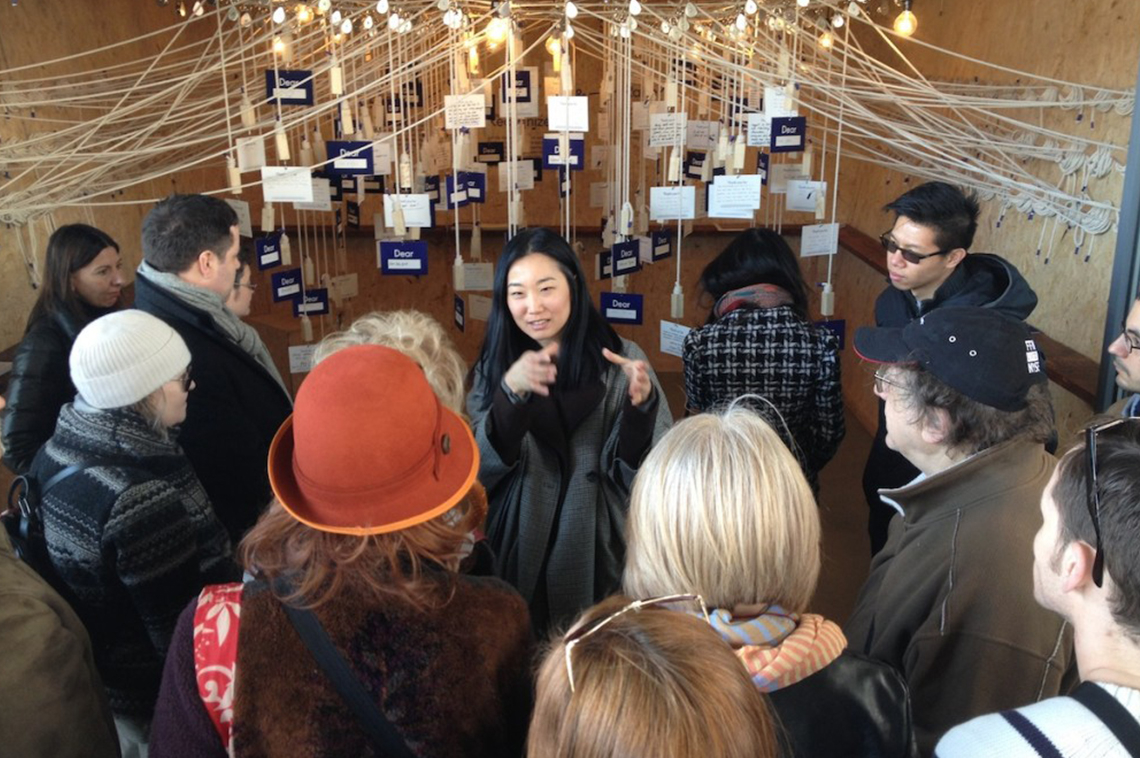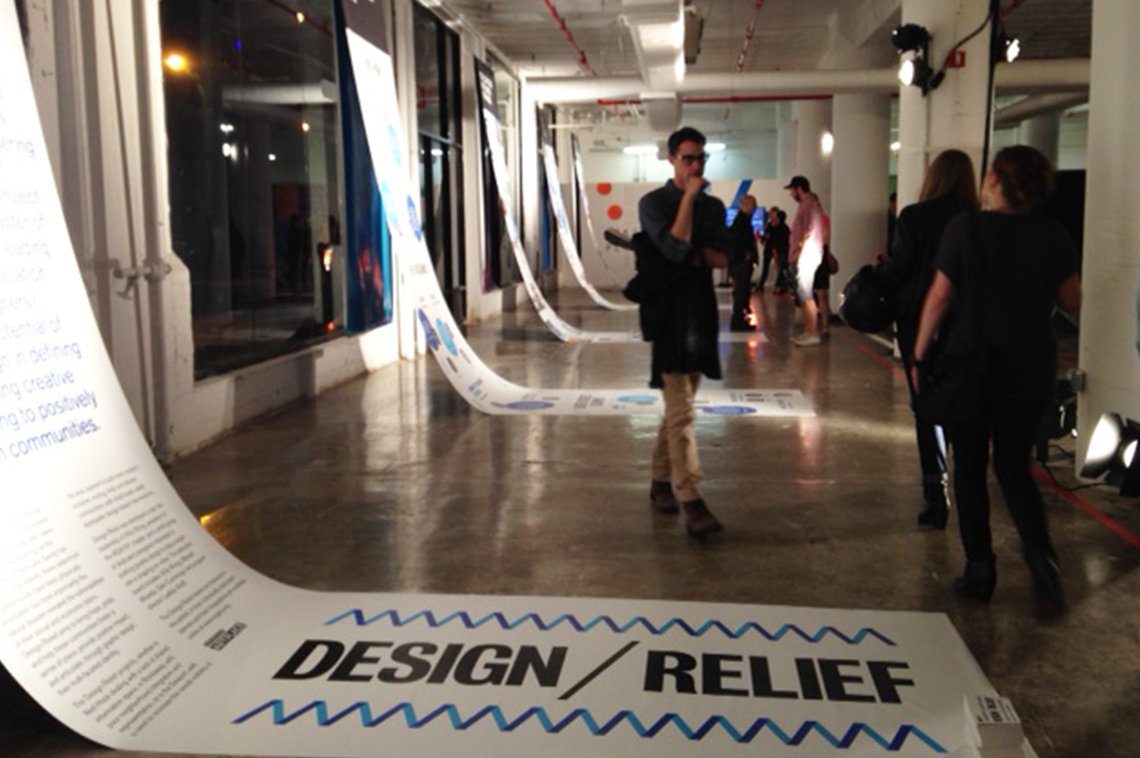

Our hearts go out to all those affected by Harvey and Irma. It’s hard to comprehend the devastation, especially to poor and underserved communities who feel the full force of not only the weather, but disproportionately, the aftermath. After physical and material safety has been reestablished, there is still much more work to do. Designers can be key players in this work — here's the story of our funded project AIGA/NY DESIGN/RELIEF (created by AIGA/NY, the New York Chapter of the professional association for graphic designers) who worked with NY communities affected by Sandy in 2012.
When first-responders have departed and short-term efforts are done, long-term recovery continues. Communities that are hit hardest by natural disasters must re-evaluate the meaning and consequences of living and working by the waterfront, as the area’s sense of place has abruptly changed forever. In Red Hook, the Rockaways, and the Seaport in Lower Manhattan- communities were physically, economically and emotionally devastated.
Laetitia Wolff, AIGA/NY Director of strategic initiatives said "In time of natural disasters, designers have very different yet critical roles to play. Whether they are called for emergency first responses, relief periods or longer-term recovery planning, their communications skills are key in (re)building communities and shaping our sense of place."
DESIGN/RELIEF jumped straight into action with neighborhood outreach. The presence of community speakers at the kickoff meeting established a clear partnership with neighborhood associations, nonprofits, small businesses, and people with a vested interest in rebuilding those places and make them more inviting.
The team produced exhibitions, events, site specific interactive installations, oral history workshops, design charrettes, talks and workshops to help neighborhoods re-establish their sense of place and identity. Teams often acted as catalysts of latent desires, lingering community needs and long-lasting aspirations. As agents of change, they’ve shown how to connect the dots while engaging communities in the creative process.
Healing
Manuel Miranda, one of the lead designers on the project told us: "Healing was something we thought about - not healing in the sense of parachuting in to 'fix' things, but just listening and understanding what the local community needs were, but also what its identity was. We learned that people who've been affected by disaster appreciate seeing their experience reflected in form. For example, in the Rockaways, the design team did a lot of interviews with locals. For one part of their project, they took quotes from the interviews, made posters out of them, and put the posters as inserts into a local newspaper called 'The Wave'. It seems like a small thing, but it was really powerful for people to see their experiences, or even just their own words about their experiences, reflected and distributed in such a public way. This was part of making things 'visible', designers have facility with the tools of production and distribution that makes language public. Most public language you see in the world is related to advertising, trying to sell something, or its news, but this project reflected people's experience with disaster. Those forms, while specific to their communities, also make a shared experience possible, and embody the site's identity in a way that makes the affected area visible to outsiders."
What was the impact?
The project demonstrated how design can help communities hit by disaster by making those communities and their experiences visible, legible, and navigable (this was the 'mantra' throughout the project). One thing that strikes Manuel Miranda about Harvey and Irma today is that ”we hear about neighborhoods and areas affected by flooding, but we don't know anything specific about them. Everything is under the general ’rubric‘ of Houston or Florida, or San Juan but cities aren't monolithic, and there's such a wide range of people and experiences in them.”
A disaster like a flood or hurricane exposes many other issues affecting those sites, and it's usually related to equity, or a lack of it. This was true in all of 3 sites, and the process of design helped to surface that for our organization, but also for the community groups they worked with.
The highest measurable visibility for Design/Relief is less a listing in media blogs, than it is about the project getting calls from people having noticed the Rockaway project on their streets: a local public school-teacher having witnessed the wheat-pasted posters around her house wanted to engage her 1st graders in stencil-making classes; a Rockaway resident who attended an event wanting to know more about the future of the projects. Encouraged by the team to tell Mayor de Blasio what was on their mind, participants repeatedly underlined the lack of consideration. “We heard a lot of people in the Rockaway say 'pay attention to us—we are part of the city,'” said team designer Danielle Aubert.
Manuel Miranda thinks that ”the potential for artists and designers with Harvey and Irma is to create forms that make the unique experience of disaster in those places unique to those places. What are Houston, or San Juan? What are the unique characteristics of the neighborhoods that were affected? What makes those places unique? And what other issues affecting those places do hurricanes expose?”
To learn more about this project download the Impact Report, for a summary of the community-centered approach which captures the lessons learned in the process and describes the various strategies used to engage community players. You can also watch the documentary about the project.
Other resources
Here are some additional resources we've recently learned about through our colleagues responding to disasters.
ArtsReady is an an online emergency preparedness service by and for arts/cultural nonprofits, provides arts organizations with customized business continuity plans for post-crisis sustainability.
CERF+ is reaching out to artists and arts organizations in affected communities as a resource to stay safe, stay updated and stay connected throughout the storm. CERF+’s Studio Protector: The Artists’ Guide to Emergencies provides safety information and recovery resources for artists. Our direct emergency financial relief is available for eligible artists who work in craft disciplines and have suffered career-threatening emergencies.
As natural disasters and social emergencies multiply, the need has grown for ethical, creative, and effective artistic response—arts-based work responding to disaster or other community-wide emergency, much of it created in collaboration with community members directly affected. Art Became the Oxygen incorporates first-person experience and guidance from respected voices deeply engaged in artistic response from Katrina to Ferguson, from Sandy to Standing Rock. It includes hundreds of links to powerful arts projects, official emergency resources, and detailed accounts for those who want to go even deeper. ART BECAME THE OXYGEN - a guide on how artists can respond to natural and civil emergencies.





